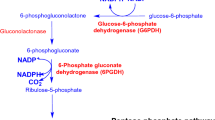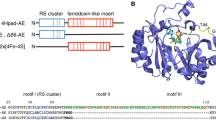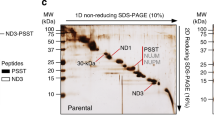Abstract
Treatment of rabbit muscle pyruvate kinase with iron/ascorbate caused an inactivation with the cleavage of peptide bond. The inactivation or fragmentation of the enzyme was prevented by addition of Mg2+, catalase, and mannitol, but ADP and PEP the substrates did not show any effect. Protective effect of catalase and mannitol suggests that hydroxyl radical produced through the ferrous ion-dependent reduction of oxygen is responsible for the inactivation/fragmentation of the enzyme. SDS-PAGE and TOF-MS analysis confirmed five pairs of fragments, which were determined to result from the cleavage of the Lys114-Gly115, Glu117-Ile118, Asp177-Gly178, Gly207-Val208, and Phe243-Ile244 bonds of the enzyme by amino-terminal sequencing analysis. Protection of the enzyme by Mg2+ implies the identical binding sites of Fe2+ and Mg2+, but the cleavage sites were discriminated from the cofactor Mg2+-binding sites. Considering amino acid residues interacting with metal ions and tertiary structure, Fe2+ ion may bind to Asp177 neighboring to Gly207 and Glu117 neighboring to Lys114 and Phe243, causing the peptide cleavage by hydroxyl radical. Iron-dependent oxidative inactivation/fragmentation of pyruvate kinase can explain the decreased glycolytic flux under aerobic conditions. Intracellular free Mg2+ concentrations are responsible for the control of cellular respiration and glycolysis.



Similar content being viewed by others
References
Ramaiah A (1974) Pasteur effect and phosphofructokinase. Curr Top Cell Regul 8: 297–345
Tornheim K (1980) Co-ordinate control of phosphofructokinase and pyruvate kinase by fructose diphosphate: a mechanism for amplification and step changes in the regulation of glycolysis in liver. J Theor Biol 85: 199–222
Lagunas R, Gancedo C (1983) Role of phosphate in the regulation of the Pasteur effect in Saccharomyces cerevisiae. Eur J Biochem 137: 479–483
Bloxham DP, Lardy HA (1973) Phosphofructokinase. In: PD. Boyer, editor. The Enzymes, 3rd Ed. Vol. 8A. New York: Academic Press: vol. 8; pp 239–278
Salas ML, Vinuela E, Salas M, Sols A (1965) Citrate inhibition of phosphofructokinase and the Pasteur effect. Biochem Biophys Res Commun 19: 371–376
Al Zaid Siddiquee K, Arauzo-Bravo MJ, Shimizu K (2004) Metabolic flux analysis of pykF gene knockout Escherichia coli based on 13C-labeling experiments together with measurements of enzyme activities and intracellular metabolite concentrations. Appl Microbiol Biotechnol 63: 407–417
Axelsson K, Mannervik B (1983) An essential role of cytosolic thioltransferase in protection of pyruvate kinase from rabbit liver against oxidative inactivation. FEBS Lett 152:114–118
Dicker E, Cederbaum AI (1988) Increased oxygen radical-dependent inactivation of metabolic enzymes by liver microsomes after chronic ethanol consumption. FASEB J 2: 2901–2906
Murakami K, Tsubouchi R, Fukayama M, Ogawa T, Yoshino M (2006) Oxidative inactivation of reduced NADP-generating enzymes in E. coli: Iron-dependent inactivation with affinity cleavage of NADP-isocitrate dehydrogenase. Arch Microbiol 186: 385–392
Murakami K, Iwata S, Haneda M, Yoshino M (1997) Role of metal cations in the regulation of NADP-linked isocitrate dehydrogenase from porcine heart. BioMetals 10: 169–174
Kayne F (1973) Pyruvate kinase, In: PD. Boyer, editor. The Enzymes, 3rd Ed. Vol. 8A, Academic Press, New York; Academic Press: p. 353–382
Lai JC, Blass JP (1984) Neurotoxic effects of copper: inhibition of glycolysis and glycolytic enzymes. Neurochem Res 9: 1699–1710
Kôrge P, Campbell KB (1994) Iron effects on myocardial enzymes depend on redox state. J Mol Cell Cardiol 26:151–162
Carvalho CS, Fernandes MN (2008) Effect of copper on liver key enzymes of anaerobic glucose metabolism from freshwater tropical fish Prochilodus lineatus. Comp Biochem Physiol A 151:437–442
Larsen TM, Laughlin LT, Holden HM, Rayment I, Reed GH (1994) Structure of rabbit muscle pyruvate kinase complexed with Mn2+, K+, and pyruvate. Biochemistry 33: 6301–6309
Larsen TM, Benning MM, Wesenberg GE, Rayment I, Reed GH (1997) Ligand-induced domain movement in pyruvate kinase: structure of the enzyme from rabbit muscle with Mg2+, K+, and L-phospholactate at 2.7 Å resolution. Arch Biochem Biophys 345: 199–206
Butterfield DA, Poon HF, St Clair D, Keller JN, Pierce WM, Klein JB, Markesbery WR (2006) Redox proteomics identification of oxidatively modified hippocampal proteins in mild cognitive impairment: insights into the development of Alzheimer's disease. Neurobiol Dis 22: 223–232
Gupta RK, Benovic JL, Rose ZB (1978) The determination of the free magnesium level in the human red blood cell by 31 P NMR. J Biol Chem 253:6172–6176
Ferrari R, Ceconi C, Curello S, Cargnoni A, Condorelli E, Belloli S, Albertini A, Visioli O. (1988) Metabolic changes during post-ischaemic reperfusion. J Mol Cell Cardiol 20 Suppl 2:119–133
Author information
Authors and Affiliations
Corresponding author
Rights and permissions
About this article
Cite this article
Murakami, K., Tsubouchi, R., Fukayama, M. et al. Iron-Dependent Oxidative Inactivation with Affinity Cleavage of Pyruvate Kinase. Biol Trace Elem Res 130, 31–38 (2009). https://doi.org/10.1007/s12011-009-8317-x
Received:
Accepted:
Published:
Issue Date:
DOI: https://doi.org/10.1007/s12011-009-8317-x




